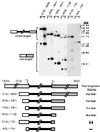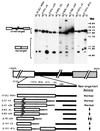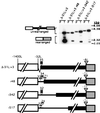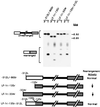Flanking regulatory sequences of the Tetrahymena R deletion element determine the boundaries of DNA rearrangement
- PMID: 10409752
- PMCID: PMC84415
- DOI: 10.1128/MCB.19.8.5631
Flanking regulatory sequences of the Tetrahymena R deletion element determine the boundaries of DNA rearrangement
Abstract
In the ciliate Tetrahymena thermophila, thousands of DNA segments of variable size are eliminated from the developing somatic macronucleus by specific DNA rearrangements. It is unclear whether rearrangement of the many different DNA elements occurs via a single mechanism or via multiple rearrangement systems. In this study, we characterized in vivo cis-acting sequences required for the rearrangement of the 1.1-kbp R deletion element. We found that rearrangement requires specific sequences flanking each side of the deletion element. The required sequences on the left side appear to span roughly a 70-bp region that is located at least 30 bp from the rearrangement boundary. When we moved the location of the left cis-acting sequences closer to the eliminated region, we observed a rightward shift of the rearrangement boundary such that the newly formed deletion junction retained its original distance from this flanking region. Likewise, when we moved the flanking region as much as 500 bp away from the deletion element, the rearrangement boundary shifted to remain in relative juxtaposition. Clusters of base substitutions made throughout this critical flanking region did not affect rearrangement efficiency or accuracy, which suggests a complex nature for this regulatory sequence. We also found that the right flanking region effectively replaced the essential sequences identified on the left side, and thus, the two flanking regions contain sequences of analogous function despite the lack of obvious sequence identity. These data taken together indicate that the R-element flanking regions contain sequences that position the rearrangement boundaries from a short distance away. Previously, a 10-bp polypurine tract flanking the M-deletion element was demonstrated to act from a distance to determine its rearrangement boundaries. No apparent sequence similarity exists between the M and R elements. The functional similarity between these different cis-acting sequences of the two elements is firm support for a common mechanism controlling Tetrahymena rearrangement.
Figures







Similar articles
-
A developmentally regulated deletion element with long terminal repeats has cis-acting sequences in the flanking DNA.Nucleic Acids Res. 2000 Mar 15;28(6):1465-72. doi: 10.1093/nar/28.6.1465. Nucleic Acids Res. 2000. PMID: 10684943 Free PMC article.
-
Cis-acting requirements in flanking DNA for the programmed elimination of mse2.9: a common mechanism for deletion of internal eliminated sequences from the developing macronucleus of Tetrahymena thermophila.Nucleic Acids Res. 2001 Jan 15;29(2):488-98. doi: 10.1093/nar/29.2.488. Nucleic Acids Res. 2001. PMID: 11139619 Free PMC article.
-
Role of micronucleus-limited DNA in programmed deletion of mse2.9 during macronuclear development of Tetrahymena thermophila.Eukaryot Cell. 2004 Apr;3(2):288-301. doi: 10.1128/EC.3.2.288-301.2004. Eukaryot Cell. 2004. PMID: 15075259 Free PMC article.
-
Programmed DNA deletions in Tetrahymena: mechanisms and implications.Trends Genet. 1996 Jan;12(1):26-30. doi: 10.1016/0168-9525(96)81385-0. Trends Genet. 1996. PMID: 8741857 Review.
-
Programmed Genome Rearrangements in Tetrahymena.Microbiol Spectr. 2014 Dec;2(6). doi: 10.1128/microbiolspec.MDNA3-0012-2014. Microbiol Spectr. 2014. PMID: 26104448 Review.
Cited by
-
Diverse sequences within Tlr elements target programmed DNA elimination in Tetrahymena thermophila.Eukaryot Cell. 2003 Aug;2(4):678-89. doi: 10.1128/EC.2.4.678-689.2003. Eukaryot Cell. 2003. PMID: 12912887 Free PMC article.
-
A novel family of mobile genetic elements is limited to the germline genome in Tetrahymena thermophila.Nucleic Acids Res. 2002 Jun 1;30(11):2524-37. doi: 10.1093/nar/30.11.2524. Nucleic Acids Res. 2002. PMID: 12034842 Free PMC article.
-
Product analysis illuminates the final steps of IES deletion in Tetrahymena thermophila.EMBO J. 2001 Jun 15;20(12):3251-61. doi: 10.1093/emboj/20.12.3251. EMBO J. 2001. PMID: 11406601 Free PMC article.
-
Boundaries of eliminated heterochromatin of Tetrahymena are positioned by the DNA-binding protein Ltl1.Nucleic Acids Res. 2019 Aug 22;47(14):7348-7362. doi: 10.1093/nar/gkz504. Nucleic Acids Res. 2019. PMID: 31194876 Free PMC article.
-
A developmentally regulated deletion element with long terminal repeats has cis-acting sequences in the flanking DNA.Nucleic Acids Res. 2000 Mar 15;28(6):1465-72. doi: 10.1093/nar/28.6.1465. Nucleic Acids Res. 2000. PMID: 10684943 Free PMC article.
References
Publication types
MeSH terms
Substances
Grants and funding
LinkOut - more resources
Full Text Sources
